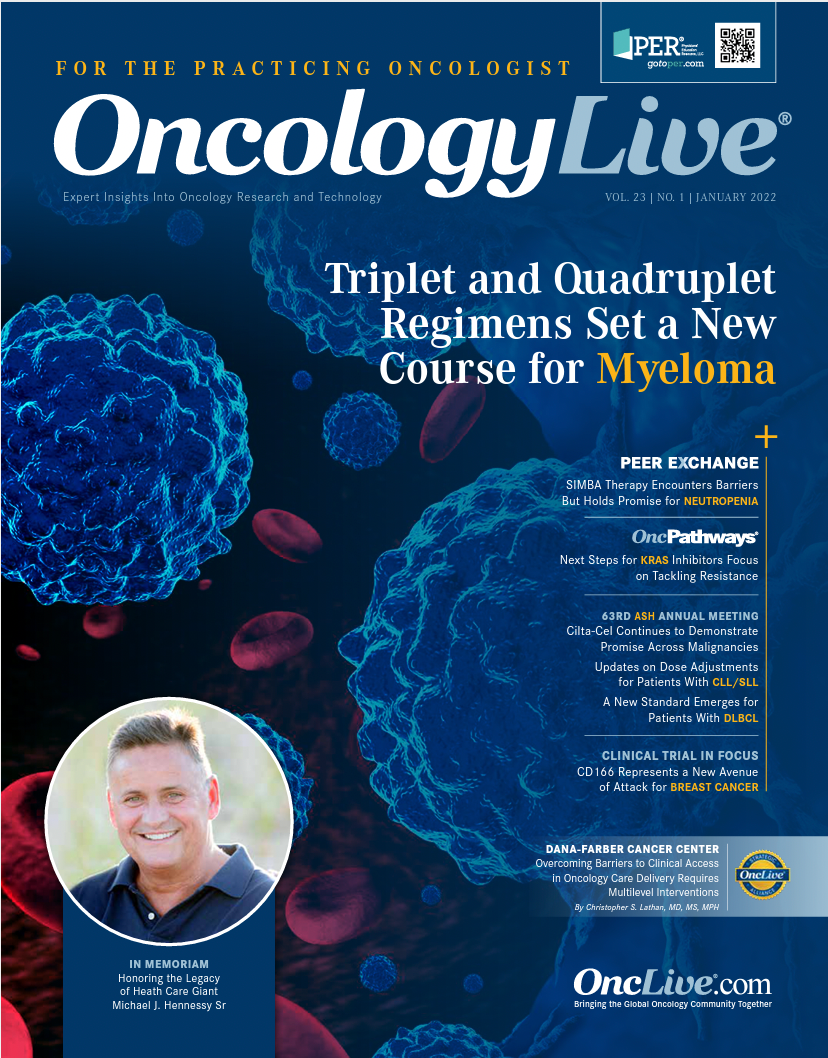Publication
Article
3D Virtual Reality Poised to Offer Superior Patient Education in Oncology
Author(s):
Patient education in oncology can often be daunting and complicated for clinicians and patients.
Douglas E. Holt, MD

Patient education in oncology can often be daunting and complicated for clinicians and patients. Traditional patient education methods such as videos, handouts, and reviewing standard medical imaging often fall short in conveying complex information. As a result, 3-dimensional (3D) virtual reality (VR) experiences are increasingly being explored as an appealing alternative method of imaging review for patients with cancer.1
“Patients struggle to know what’s happening within their own bodies,” said Douglas E. Holt, MD, a radiation oncologist at Gamma West Cancer Services in Idaho Falls, Idaho, in an interview with OncologyLive®. “They’re making decisions being somewhat or quite uninformed about what’s going on. VR [provides an] opportunity to help patients be engaged in their own disease process and on decisions of the future of their cancer [journey].”
Holt developed and implemented a program to demonstrate how VR can improve patient education.1 He received the 2021 Association of Community Cancer Centers (ACCC) Innovator Award for his work and presented the findings at the ACCC 38th (Virtual) National Oncology Conference in November 2021.2
Although most patients want to be as informed as possible about their condition, studies have found that up to 80% of information presented to patients by clinicians is forgotten almost immediately. As much as 50% of the information that is remembered by patients is retained inaccurately, and patient recall tends to be poorer as greater amounts of information are presented. These issues can be worsened by factors including poor health literacy among patients, the amount and complexity of information presented, language barriers, and the stress a patient is feeling because of the diagnosis.1,2
By itself, verbal discussion between patient and clinician has been found to be the least effective educational method. Standard medical imaging contains most of the information patients need to understand their condition but is difficult to interpret without years of training. Because of the shortcomings of current patient education strategies, patients often lack the context and understanding to participate in discussions about their condition and to make decisions concerning their care.3
“Medical imaging has a lot of the information right there; it’s just in a form [that] patients can’t understand,” Holt said. “VR is a way that clinicians can intuitively show someone their own body, where the problem is with their tumor, and the extent of their disease. [Clinicians] can show patients why they are having the symptoms they’re having and then help them understand what their treatment would look like.”
Meeting Patients Halfway
Holt sought to address the disconnect in patient education in oncology by using VR in a proofof-concept study. The goal of the trial was to identify and address the technical challenges of implementing VR in the clinic and to objectively measure subjective patient experiences with the technology. Holt partnered with clinical psychology professionals and a psychometrician utilizing a mixed-methods approach consisting of quantitative surveys and qualitative semistructured interviews. A qualitative analysis was also performed to identify commonly shared themes among patients.2
The median age of the 25-patient population was 59 years (range, 11-95). The population included patients with tumor sites in the central nervous system, head and neck, breast, thorax, gastrointestinal tract, and pelvis. The median time from diagnosis to the VR education experience was 5 months (interquartile range, 3-19). Each VR session lasted approximately 5 to 7 minutes and included patients and their caregivers.
During the session, patients wore a VR headset and used 2 hand controls to navigate the experience. The system combined individual slices of medical images to create a 3D rendering of the patient’s tumor site that could be viewed from a third-person perspective. Patients could freely move about, rotate, and zoom in and out on their tumor to get a better understanding of its size, location, and potential impact on neighboring organs.
After the VR session, patients rated their understanding of their tumor/disease at a mean level of 9.2 out of 10, with a 10 being full understanding, compared with 5.6 before the session (P < .0001).
Patients were also asked to identify their preferred method for medical imaging review; 96.9% of patients chose VR vs 3.1% who selected imaging review via a standard computer screen. Members of the study population ranked what they considered the top educational tool for understanding their disease after the VR session. VR received the top ranking 83.3% of the time, followed by verbal discussion (8.3%), self-research (5.6%), and drawings (2.8%).
VR also outperformed imaging review via a standard computer screen in an understanding of disease and treatment analysis on a scale of 1 to 3, with 3 being full understanding. The mean patient rating with the VR experience was higher than that for the computer screen in every category surveyed: tumor appearance (2.8 vs 1.3, respectively), tumor size (2.8 vs 1.4), tumor location (2.9 vs 1.5), organs adjacent to tumor (2.9 vs 1.2), tumor- related symptoms (2.7 vs 1.6), treatment rationale (2.9 vs 2.0), radiation target (3.0 vs 2.0), and radiation toxicity (2.8 vs 1.3). On the same 3-point scale, VR also outperformed the computer screen when patients rated the experience for reduction in anxiety (2.2 vs 1.1), feeling of engagement in health care (2.8 vs 1.5), and satisfaction (2.9 vs 1.6). Investigators asked patients to rate the level of importance of VR in viewing their tumor/disease. The method attained a mean score of 9.1 out of 10.
Patients gave additional feedback on the VR imaging review on a 5-point scale from “strongly disagree” to “strongly agree.” Most patients strongly agreed (78.9%) or agreed (18.4%) that they were comfortable with VR for medical imaging review; 2.7% strongly disagreed.
The statement, “important for VR experience to be shared via multiuser platform” was strongly agreed with by 64.9% of patients and agreed with by 32.4% of patients. Most patients also strongly agreed with the statements “VR increased trust in physician and treatment team” (75.0%), “want VR to be used in own healthcare in future” (81.6%), and “VR should become standard-ofcare in imaging review” (78.9%). Patients did not strongly disagree or disagree with any of the other statement options.
“The general response [to VR education] was amazingly positive,” Holt said. “A lot of patients would say something [such as], ‘that was incredible,’ or ‘that was amazing.’ With cancer consultations, those are not words you usually hear.”
Holt noted that despite the overwhelmingly positive patient reaction, the VR approach is still far from being the standard of care in oncology imaging review. The current form is not accessible to most patients with cancer and is not scalable. According to Holt, issues affecting the scalability of the technique include many cancer care facilities lacking adequate software and hardware, challenges with sterilization, and the long preparation time with patients that is needed for each session.
There are several other ongoing or completed studies aiming to implement VR approaches in cancer care. Liimatainen et al created a novel interface that utilized VR to visualize 3D histology data. Through an interactive VR application, the user can set visualization properties, select different samples and features, and interact with various objects, which is not possible in the traditional 2-dimensional image view used in digital pathology.4
In another study, Wang et al constructed an application that ran on a commercially available stand-alone VR headset, allowing patients to view a virtual simulation of radiotherapy treatment. The patient’s computed tomography simulation data were converted into a 3D translucent virtual human shown lying on a treatment table as visible yellow radiation beams were delivered to the target volumes in the patient. Among the 43 patients with cancer enrolled in the study, 74% strongly agreed that the session gave them a better understanding of how radiotherapy would be used to treat their disease. Of the 21 patients who expressed any anxiety about radiotherapy prior to the study, 57% said that the VR session helped reduce their anxiety about undergoing treatment.5
“The future for patient education in oncology and the rest of medicine is VR,” Holt concluded. “It’s a format that [allows] patients to understand intuitively what’s happening within their own bodies. The next steps would be to do larger studies, in oncology and then outside of oncology, to really be able to evaluate some of the other tangible benefits of this to patients [beyond] education.”
References
- Kessels RPC. Patients’ memory for medical information. J R Soc Med. 2003;96(5):219-222. doi:10.1258/jrsm.96.5.219
- Holt, DE. 3D virtual reality: changing the standard of care for patients with cancer and their caregivers. Presented at: Association of Community Cancer Centers 38th National Oncology Conference; November 9-10, 2021; virtual. Accessed December 7, 2021. bit.ly/3dEGl4S
- Friedman AJ, Cosby R, Boyko S, Hatton-Bauer J, Turnball G. Effective teaching strategies and methods of delivery for patient education: a systematic review and practice guideline recommendations. J Cancer Educ. 2011;26(1):12-21. doi:10.1007/s13187010-0183-x
- Liimatainen K, Latonen L, Valkonen M, Kartasalo K, Ruusuvuori P. Virtual reality for 3D histology: multi-scale visualization of organs with interactive feature exploration. BMC Cancer. 2021;21(1):1133. doi:10.1186/s12885-021-08542-9 Wang LJ, Casto B, Luh JY,
- Wang SJ. Virtual reality-based education for patients undergoing radiation therapy. J Cancer Educ. Published online September 24, 2020. doi:10.1007/s13187-020-01870-7









